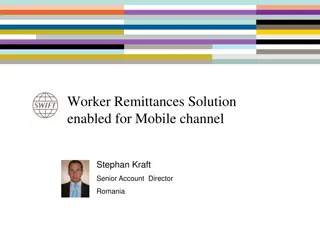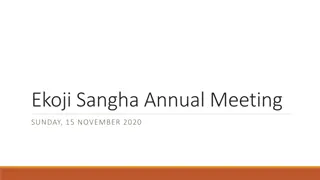
Informal Economy Workers: Characteristics, Significance, and Statistics
Explore the characteristics and significance of informal economy workers like home-based workers, domestic workers, street vendors, and waste pickers. Learn about the statistical challenges, policy demands, and the importance of having statistics on these worker groups to drive economic development and social improvement.
Download Presentation

Please find below an Image/Link to download the presentation.
The content on the website is provided AS IS for your information and personal use only. It may not be sold, licensed, or shared on other websites without obtaining consent from the author. If you encounter any issues during the download, it is possible that the publisher has removed the file from their server.
You are allowed to download the files provided on this website for personal or commercial use, subject to the condition that they are used lawfully. All files are the property of their respective owners.
The content on the website is provided AS IS for your information and personal use only. It may not be sold, licensed, or shared on other websites without obtaining consent from the author.
E N D
Presentation Transcript
2024 REGIONAL COURSE ON INFORMALITY: DEFINITIONS, MEASUREMENTS, SDGS, AND OTHER POLICY INDICATORS SESSION 1.5 A CLOSER LOOK AT SPECIAL GROUPS OF INFORMAL ECONOMY WORKERS
OUTLINE Home-based workers, domestic workers, street vendors and market traders, and waste pickers: characteristics and significance Core needs and policy demands Statistical challenges and definitions Examples of demand for statistics by worker groups Networks of organizations of workers in informal employment
DOMESTIC WORKERS HOME-BASED WORKERS - STREET VENDORS AND MARKET TRADERS WASTE PICKERS Characteristics old/traditional occupations, or the results of subcontracting chains largely informal employ large numbers of women; often low earnings operate mostly without government regulations and social protection largely invisible in policy discussions, needs rarely addressed
WHY IMPORTANT TO HAVE STATISTICS ON THESE GROUPS OF WORKERS? SIGNIFICANT PART OF THE LABOUR FORCE Main groups: Ex. Thailand: 2017, HBWs + DWs + SVs + Market Traders (+motorcycle taxi drivers) = 21.5% of Bangkok employment; 20.0% of urban Thailand; 15.6% of national employment HBWs: 9% of total employment globally (ILO) 8% of total employment in developing and emerging economies of Asia and the Pacific 10% in developing and emerging economies of East and Southeastern Asia (excl. China) DWs: 2.3% of total employment globally (ILO) 2.1% in developing and emerging economies of Asia and the Pacific 1.5% in developing and emerging economies of East and Southeastern Asia SVs and Market Traders India 2022-23: 3% of national employment; 6% in urban India Thailand 2017: 2.1% national; 2.6% in urban Thailand Waste pickers? Least measured. Brazil 2019: 0.3% of employment Economic development : focus on improving the economic and social situation of workers in these jobs in addition to developing programmes in new economic sectors
SIGNIFICANCE: SIX GROUPS OF URBAN INFORMAL WORKERS INDIA 2022-23 * Includes all informal workers in the general industry category. All other groups potentially include both formal and informal workers in reality: 4 MAJOR GROUPS ARE 100% INFORMAL JOBS Groups of workers by sex in India and urban India, 2022-23: Millions and percent of employment in parentheses Women Men TOTAL Women URBAN INDIA Men TOTAL Worker s Group INDIA 73.93 (13.7) 7.98 (1.5) 44.29 (28.6) 5.59 (3.6) 29.64 (7.7) 2.39 (0.6) 21.21 (12.4) 6.38 (3.7) 11.23 (29.4) 4.62 (12.1) 9.98 (7.5) 1.76 (1.3) Home-Based Workers Domestic Workers 16.54 (3.1) 0.59 (0.1) 6.90 (4.5) 0.10 (0.1) 9.64 (2.5) 0.49 (0.1) 10.67 (6.2) 0.34 (0.2) 5.08 (13.3) 0.06 (0.2) 5.59 (4.2) 0.28 (0.2) Street Vendors/mkt.traders Waste Pickers 68.63 (12.7) 21.64 (4.0) 189.31 (35.0) 6.89 (4.5) 0.08 (0.1) 63.85 (41.3) 61.74 (16.0) 21.56 (5.6) 125.45 (32.6) 17.24 (10.1) 10.03 (5.9) 65.88 (38.5) 1.25 (3.3) 0.03 (0.1) 22.27 (58.4) 15.99 (12.0) 10.00 (7.5) 43.60 (32.8) Informal Construction* Informal Transport* All Groups
COMMON CORE NEEDS AND POLICY DEMANDS FOR THESE GROUPS OF WORKERS Recognition as workers who make a valuable contribution to the economy and society as part of the economically active population The right not to be subjected to punitive regulations, policies, or practices (ex. goods confiscation) The right to enjoy specific promotional and protective measures for their activities, including protection against exploitation by intermediaries (ex. for work on contract) Being included in economic development policies--local policies to begin with. Steps proposed in the ILC Recommendations on the Transition from the Informal to the Formal Economy (R204)- what they might mean: from the perspective of workers (the points above) and from the perspective of different categories of workers
SPECIFIC DEMANDS FOR POLICY: Home-based workers (including homeworkers/dependent contractors) protection from being subjected to poor quality raw materials, arbitrary cancellation of work orders, arbitrary rejection of goods, or delayed payments (sub-contracted) right to basic infrastructure services water, electricity, sanitation at their homes, which are their workplaces, including access to public transportation (transport goods) access to markets for their goods and services right to fair prices in markets (for independent workers), and fair piece-rates (sub- contracted, dependent contractors)
SPECIFIC DEMANDS FOR POLICY: Domestic Workers the right to a living wage and working conditions such as rest hours, weekly time off and leave, overtime pay, sick leave, health insurance, and pensions freedom from harassment or abuse by recruiters or employers (households) freedom from exploitation by agencies, other intermediaries and digital labor platforms (e.g. for cross-border migrants) implementation of ILO C189 - Domestic Workers Convention, 2011 (No. 189) and accompanying Recommendations as a minimum set of conditions in every country. (contingent on country ratification and enforcement.) See: ILO (2021) Making decent work a reality for domestic workers: Progress and prospects ten years after the adoption of the Domestic Workers Convention, 2011 (No. 189)
SPECIFIC DEMANDS FOR POLICY: Street Vendors and Market Traders Operate in public space affected by urban policies, national and local regulations. freedom from harassment, confiscation of goods, evictions, arbitrary warrants and convictions, arbitrary relocations, unofficial payments and/or bribes freedom from fear of authorities and mafia elements the right to have the natural markets of street vendors recognized and built into urban zoning and land allocation plans the right to vend in public spaces under fair and reasonable conditions (which balance competing rights of different users of public spaces) the right to fair and transparent allocation of permits and licenses freedom from exploitation by intermediaries who take high fees
SPECIFIC DEMANDS FOR POLICY: Waste pickers freedom from harassment, bribes, and evictions by city authorities the right to access recyclable waste (for sorting) without restrictions access to recyclables markets provision of infrastructure: central sorting facilities, transportation to recycling sites the right of their member organizations to bid for solid waste management contracts (successful in some cities); inclusion in public waste collection systems
STATISTICAL CHALLENGES IN IDENTIFYING GROUPS Location of work makes them difficult for surveys to capture (particularly Street Vendors, Waste Pickers) Data from multiple variables are required for the identification of some of these categories Classification of industries and occupations either not sufficiently detailed or they are not used Progress in international guidelines on place of work since 20thICLS Resolution: now a key variable
How Question on Place of Work Has Been Asked: an Example No fixed work place Work place located in: Dwellings: Own dwelling Structure attached to own dwelling Open area adjacent to own dwelling Detached structure adjacent to own dwelling Other permanent structures Own enterprise/office/shop but away from own dwelling Employer s dwelling unit Employer s enterprise/office/shop but outside employer s dwelling Built markets Open spaces Street with fixed location Street mobile Construction site Others These categories are defined by type of physical structure: 20thICLS ICSE18 key variable identifies basic categories based on type of location
BASIC CATEGORIES RECOMMENDED BY 20th ICLS FOR PLACE OF WORK KEY VARIABLE Work at home: own home (or area outside); own household farm; With a fixed place of work outside the home: client s or employer s home; employer s workplace or site; own business premises; client s workplace or site; no single type of location; No fixed place of work: water, air or land-based vehicle; door-to-door; street or other public space; market; Other type of location
Identification and measurement of groups: HOME-BASED WORKERS Home-based workers: the category of primarily nonagricultural workers who perform remunerative work (for pay or profit) in their own home or adjacent grounds or premises (some do processing of agricultural products) Types of workers who work from home: Independent workers without employees working in their own home Homeworkers --sub-contracted wage or piece rate workers who work in their own home for a firm or its contractors Contributing Family Workers Note: Home-based workers is often used to refer to all categories.
HOME-BASED WORKERS - DISTINCT STATUS IN EMPLOYMENT CATEGORIES Independent workers : work independently at home, self-employed Take entrepreneurial risks (make investments, obtain loans, buy equipment and sell their finished goods themselves) Include employers (with hired workers), own-account operators (without hired workers) A. Sub-contracted piece rate or wage workers who work in their own homes for a firm or its contractors. Sub-contracted homeworkers provide their own workspace and are not directly supervised by the company for which they produce. Are often treated as independent workers. But: they are dependent on the contractor for work orders, raw material, specifications and access to markets for sale of finished goods. Statistically Dependent contractors (meet ICSE18 criteria), or Employee (if their status is changed by government policy) (Independent workers without employee if dependency criteria are not met.) B. Contributing family workers (dependent) C.
HOME-BASED WORKERS AND HOMEWORKERS-contd Classifying these workers was a major issue in the 20thICLS revision of International Classification of Status in Employment, i.e. capturing workers who occupy an intermediate status Dependent Contractor category (ICSE18). Identification of home-based workers and homeworkers requires having data on: place work, activity status, sector, degree of autonomy, type of access to market, and sub-contracting terms.
Identification and measurement: DOMESTIC WORKERS Domestic workers are unique; they are: employees of households, or employed by an agency and dispatched; or service providers employed for profit to provide domestic services to households: as independent workers, or as dependent contractors (access customers through an agency) Of the 4 main groups considered, domestic workers are the only one routinely identified in national statistics still they are often under-enumerated and misclassified -for example, as home-based workers Can be identified by using a combination of national occupational codes, industry codes, place of work, and informal work status
Identification and measurement: STREET VENDORS AND MARKET TRADERS Street vendor -- those who sell goods in public spaces other than a store, and those who sell services in public spaces, such as: hairdressers or barbers; shoe shiners and repairers; and bicycle, motorcycle, car, or truck mechanics. Street -- interpreted broadly to include vendors who sell in non-private spaces, including sidewalks, parks, alleyways and other open-air locations; around construction sites, sports stadiums, transport junctions; and on public transport. Market traders are those who sell goods or provide services in built markets on publicly, or privately, owned land
STREET VENDORS AND MARKET TRADERS-Compilation methods Persons vending goods at public places are usually identified by their occupational classification Persons selling services in public places can be identified by using occupational classification or industrial classification Use of either classification usually would need to be combined with place of work codes
WASTE PICKERS Workers who do the primary collecting and sorting of waste. They extract and reclaim re-usable and recyclable materials from mixed types of waste that others have cast aside. (May collect directly from households) Most countries do not have a specific code for identification either in their occupation or industry classification Relevant industry or occupation codes relate to garbage collection, transportation and disposal. Example from Brazil brief-- Combination of: Occupation 9612: Refuse Sorters Waste pickers Cross-tabulation of Occupation 9611-Garbage and Recycling Collectors (mostly formal) with IND 38000-Waste collection, treatment and disposal; materials recovery & with Informal status Subset = find additional waste pickers Data from a household survey likely will be an underestimate (mobile/seasonal populations). Other modes of data collection are important for this group at this point. Citizen-generated data initiatives.
DEMAND FOR STATISTICS BY WORKER ORGANIZATIONS - ILO-WIEGO & WIEGO PUBLICATIONS (www.wiego.org) In addition to: ILO. 2023 & 2018. Women and Men in the Informal Economy WIEGO. 2024. Street Vendors and Market Traders in 12 Countries: A Statistical Profile. Brief no. 40 ILO & WIEGO. 2022. Domestic Workers in the World: A Statistical Profile. Brief no. 32 ILO & WIEGO. 2021. Home-based Workers in the World: A Statistical Profile. Brief no. 27 Country briefs including waste picker statistics: The Impact of Covid-19 on Employment in India: WIEGO Brief no. 38 Workers in Informal Employment in El Salvador: A Statistical Profile, 2019-2021. WIEGO Brief no. 36 Workers in Informal Employment in Peru, WIEGO Brief no. 34 Informal Workers in Brazil, WIEGO Brief no. 33 Statistics on Waste Pickers in Brazil. WIEGO Brief No. 2 Requests from: International Domestic Worker Federation (IDWF); HomeNet International (HNI); StreetNet International (SNI); International Association of Waste Pickers; the Self-Employed Women s Association (SEWA); country worker groups.
DEMAND FOR STATISTICS BY WORKER GROUPS AND WIEGO PUBLICATIONS HomeNet South Asia requester and collaborating group: Koolwal, G and J Vanek. 2020. Home-Based Workers in Bangladesh. WIEGO brief no. 25 Raveendran, G. 2020. Home-Based Workers in India. WIEGO brief no. 23 Akhtar, S. 2020. Home-Based Workers in Pakistan. WIEGO brief no. 26 Koolwal, G and J. Vanek. 2021. Home-Based Workers in Nepal, 2017/18. WIEGO brief no. 28
NETWORKS OF MEMBER-BASED ORGANIZATIONS OF INFORMAL WORKERS Networks, their affiliates & other MBOs are potential requesters: HomeNet International HomeNet South Asia HomeNet Southeast Asia HomeNet Thailand StreetNet International: 5 affiliates in Asia International Domestic Workers Federation (affiliates in Bangladesh, Cambodia, Hongkong, India, Indonesia, Malaysia, Philippines, South Korea, Sri Lanka, Taiwan, Thailand) International Alliance of Waste Pickers (2024)





















